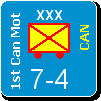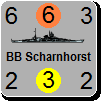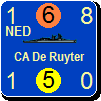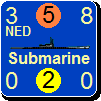warspite1
Posts: 41353
Joined: 2/2/2008
From: England
Status: offline

|
I had previously played 5th Edition of World In Flames (WIF) – although that was the best part of 20 years ago. Real life then took over and so I haven’t had a chance to play since. Realistically, but for MWIF, I would not be able to until maybe retirement…
With MWIF though, and the fact that I do not need to commandeer half the house to set the game up, I am able to take up arms once again. But would I still want to play it? Would it be any good?
I look back on the time playing WIF with good memories. The game was fun, good looking, but incredibly challenging. I lost more games than I won, but that did not dim the sense of enjoyment (well it did during the actual game of course because losing sucks… ). ).
I first found out about Matrix Games and WIF being made for the computer in 2008. In all the time waiting for the game I never really considered whether I would actually like playing the game after all these years – after all times and tastes change – and since 1996 there has been lots of good computer war games to spend hard earned leisure time with. I guess I just assumed I would continue to enjoy the game when it finally came out and I would just pick up where I left off (notwithstanding the rules (and some counters) have changed radically since the 5th Edition).
So having got the game and dived in with Global War and all the optional rules, 1. What was the reality like? 2. How does MWIF actually compare to board game WIF? 3. How does MWIF (which is a faithful reproduction of the board game) compare to other war games?
I am pleased to say that the answer to the last two questions is pretty straightforward:
2. How does MWIF actually compare to board game WIF?
There is no discernable difference. The game plays like WIF, just as it’s designed to. There are swings and roundabouts in terms of “what is better, computer or table top?” On the plus side, with MWIF, you cannot misinterpret the rules, although sometimes on the negative side, with MWIF you cannot misinterpret the rules  . Joking aside, this factor cannot be over emphasised. Learning to play, and know intimately, all 64-pages of rules with the board game version, is not something a player can do unless they really have a lot of time and energy. . Joking aside, this factor cannot be over emphasised. Learning to play, and know intimately, all 64-pages of rules with the board game version, is not something a player can do unless they really have a lot of time and energy.
A downside is that the computer game is very unforgiving if you miss a move or an attack and you have gone on to the next stage – whereas with a human opponent opposite you, you could always agree to going back a step. However, after a few disastrous consequences of playing too hastily, I suspect that such forgetfulness will disappear quite quickly.
The only other real difference is that you get more of an overall feel for the game when you can see the entire map, and the counters upon it, all laid out in front of you. However, given that lack of ability to set up said map is one of the reasons many stopped playing (or never started) that is just a necessary evil.
3. How does WIF/MWIF compare to other war games?
Since I stopped playing WIF, I have played a few computer wargames (I am an avid wargamer in terms of time spent playing rather than different numbers of games) and have hugely enjoyed only three really – Civ II / IV, Rome Total War and Commander The Great War. These have been fun and certainly “scratched an itch” but I felt there was nothing that ever really came close to WIF. With all three, I never felt that I would never play anything else. When I was playing WIF, that was the feeling I had. Why?
WWII is my favourite period of military history – and what WIF does is to allow a player control over the armies, navies and air forces that took part in the biggest conflict in human history. Each major power feels like its historical equivalent in terms of the make-up of its forces, the goals it needs to accomplish, the advantages and disadvantages it has relative to other powers, and the side it’s on. But subject to a few hard and fast rules that ensure every game of WIF/MWIF has a WWII framework, a player is free to choose a wide range of strategic alternatives.
Aesthetics are important to me in a wargame. WIF (with the notable exception of the Final Edition maps) was quite simply, beautiful. The counters are colourful, easy to read in terms of information contained vs looks, and well presented. Nato symbols for the land units, full colour silhouettes for the aircraft and ships. Due to the limitations of a cardboard game, the presentation of the land units is less than optimal (although still well done), but the game makers, Australian Design Group, make a thoroughly brilliant job of the aircraft and ship units. This is a strategic level game remember, and yet every single ship (plus some “what-if’s” too) of light cruiser class and above, is represented in the game. Genius! Fancy up gunning the Scharnhorsts?  Fancy building the Malta-class carriers and Lion-class battleships for the Royal Navy? Fancy building the Malta-class carriers and Lion-class battleships for the Royal Navy?  Or giving Mussolini the aircraft carriers required for Mare Nostrum? Or giving Mussolini the aircraft carriers required for Mare Nostrum?  Well they are all possible with this game - and much more. The treatment of the aircraft is a kind of halfway house between the two. The counters represent hundreds of aircraft but you get to fly named aircraft types to each combat – not faceless, generic “Fighters” or “Bombers”, but, for example, Mustangs or Heinkels. Well they are all possible with this game - and much more. The treatment of the aircraft is a kind of halfway house between the two. The counters represent hundreds of aircraft but you get to fly named aircraft types to each combat – not faceless, generic “Fighters” or “Bombers”, but, for example, Mustangs or Heinkels.
Another great thing about WIF/MWIF is the replayability factor. Because there are no set starting positions, because the counter mix is not guaranteed, because the reinforcements you build are chosen at random (within the build types) and because of the randomness of weather, turn length and dice, there are no “perfect” attacks/strategies.
World In Flames is a game that either side (or major power if playing with more than two) can win. It is a monster of a game and yet designed to be fun. It is not a logistics game. Yes, a game of this size and complexity will have an element of micro-management, but this aspect is sensibly handled. There is very little time spent on boring “housekeeping” and “admin” type stuff. Even when not engaged in combat, as a player you are constantly having to think ahead – to properly plan what you want to do and what you need to achieve your goals. You then have to get those assets in the right place at the right time.
So yes, this game beats all others I have tried hands down.
So this leads to the initial question – what was the reality like, playing again after all these years?
Well one thing is for certain – I had forgotten the detail of just how challenging this game is. I am doing an AAR – Global War with all the trimmings (optional rules) - and as anyone who has read any of it will testify, if has been a catalogue of mistake after mistake after embarrassing mistake. I have forgotten to build AMPH with the Commonwealth, I have forgotten to properly place HQ’s so that supply has been an issue, I have forgotten to carry out attacks. There is just so much to do!! 
But do you know what? I don’t care – because it’s fun! The reality is, I am enjoying having this old, long lost friend back again! 
The game has some bugs still being ironed out, but that is understandable given the enormity of the project, and already there have been four patches, so the support for the game is there, and I am sure, will continue to be. I am up to Sep/Oct 1941 and – touchwood – have had no game-stopping bugs.
So a huge thank-you to Matrix, and above all to Steve   , for bringing the best strategic game ever to the computer. And of course equally huge thanks to Harry Rowland and ADG for designing such a masterpiece in the first place , for bringing the best strategic game ever to the computer. And of course equally huge thanks to Harry Rowland and ADG for designing such a masterpiece in the first place   . .
< Message edited by warspite1 -- 11/25/2013 1:57:45 PM >
_____________________________
England expects that every man will do his duty. Horatio Nelson October 1805 
|
 Printable Version
Printable Version


 ).
).  . Joking aside, this factor cannot be over emphasised. Learning to play, and know intimately, all 64-pages of rules with the board game version, is not something a player can do unless they really have a lot of time and energy.
. Joking aside, this factor cannot be over emphasised. Learning to play, and know intimately, all 64-pages of rules with the board game version, is not something a player can do unless they really have a lot of time and energy.  Fancy building the Malta-class carriers and Lion-class battleships for the Royal Navy?
Fancy building the Malta-class carriers and Lion-class battleships for the Royal Navy?  Or giving Mussolini the aircraft carriers required for Mare Nostrum?
Or giving Mussolini the aircraft carriers required for Mare Nostrum?  Well they are all possible with this game - and much more. The treatment of the aircraft is a kind of halfway house between the two. The counters represent hundreds of aircraft but you get to fly named aircraft types to each combat – not faceless, generic “Fighters” or “Bombers”, but, for example, Mustangs or Heinkels.
Well they are all possible with this game - and much more. The treatment of the aircraft is a kind of halfway house between the two. The counters represent hundreds of aircraft but you get to fly named aircraft types to each combat – not faceless, generic “Fighters” or “Bombers”, but, for example, Mustangs or Heinkels. 





















 New Messages
New Messages No New Messages
No New Messages Hot Topic w/ New Messages
Hot Topic w/ New Messages Hot Topic w/o New Messages
Hot Topic w/o New Messages Locked w/ New Messages
Locked w/ New Messages Locked w/o New Messages
Locked w/o New Messages Post New Thread
Post New Thread